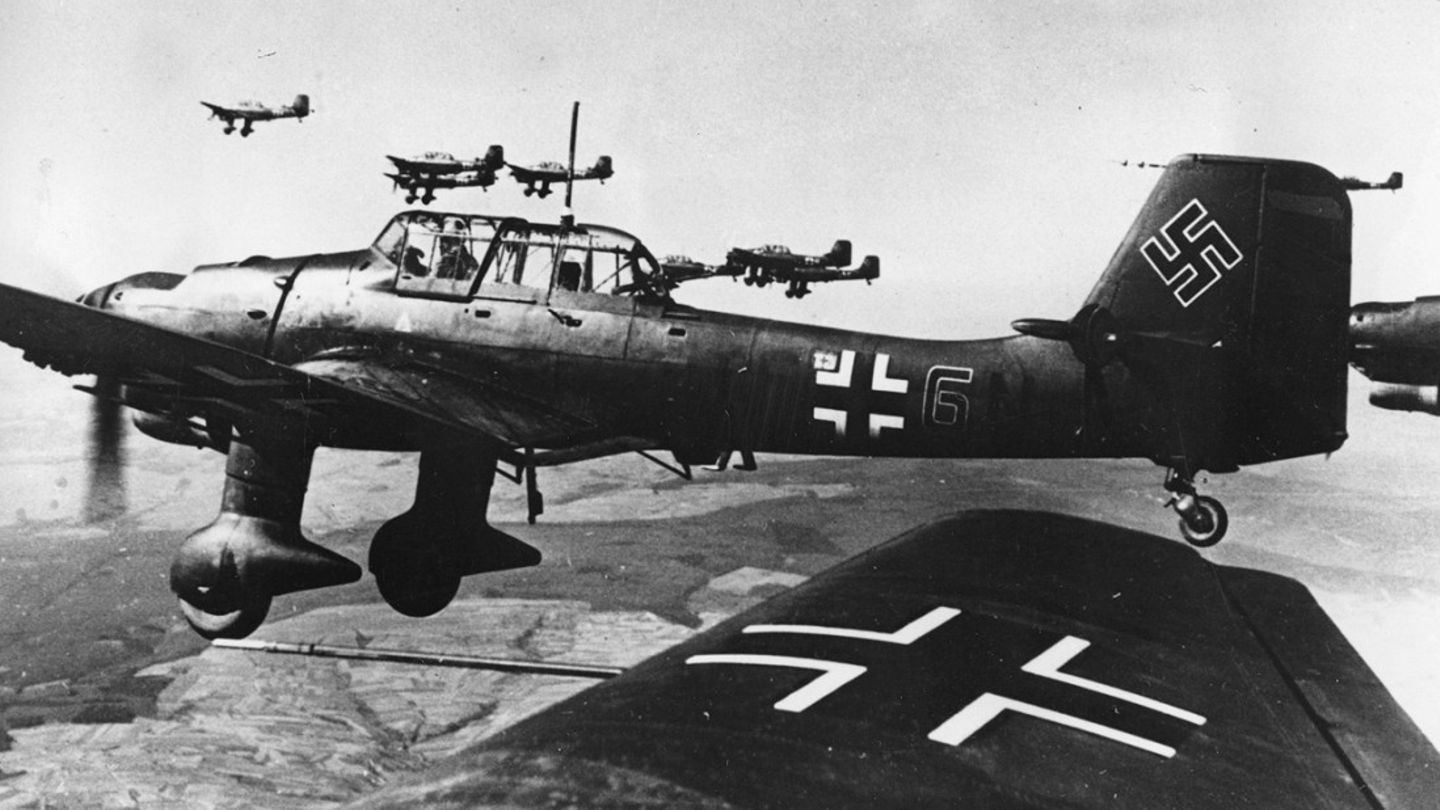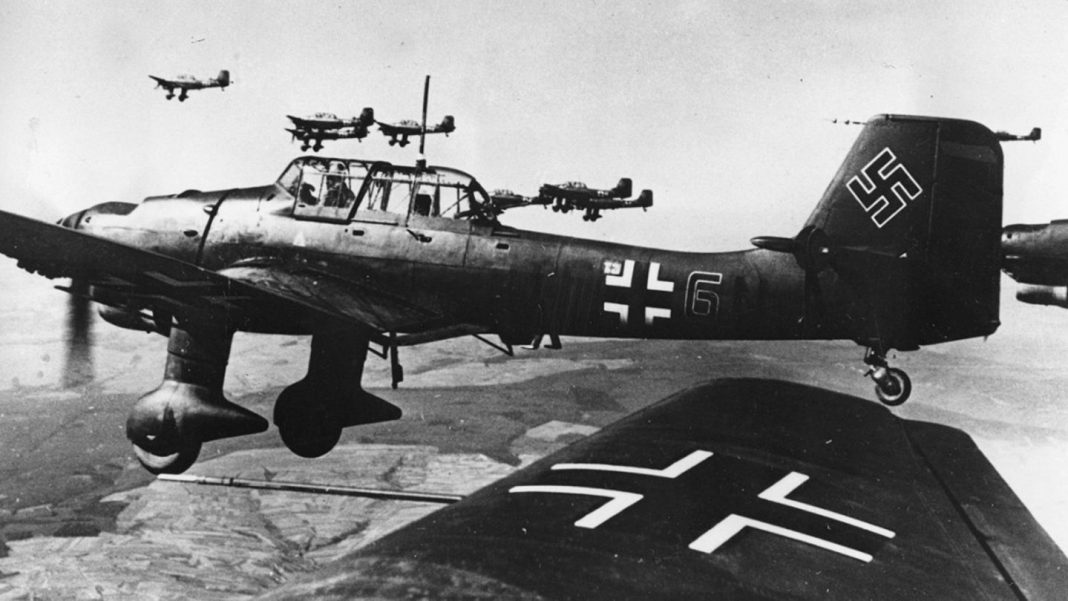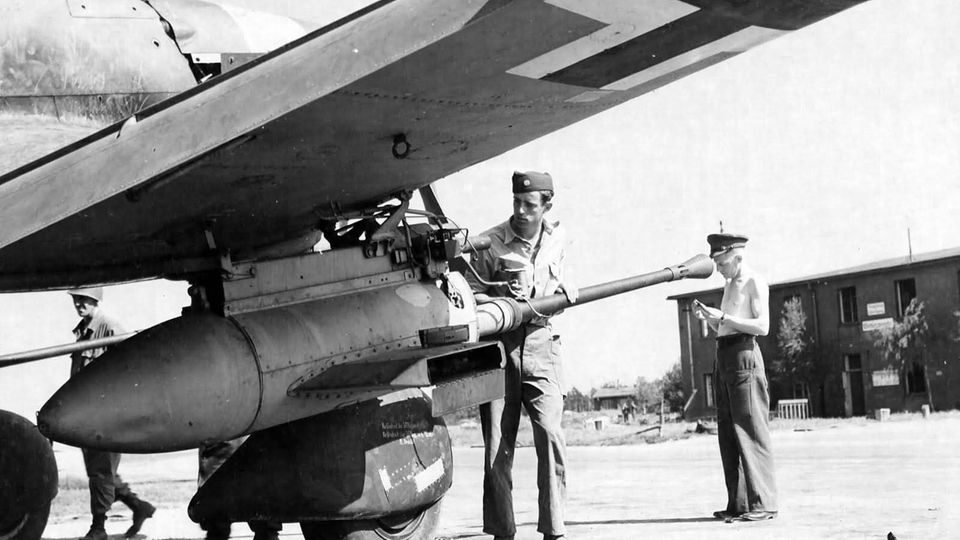The Second World War
Ju 87 Stuka – this machine bombed Hitler’s lightning victories induced

In the battle of Britain, the British wheel hold shoot on slow machines.
© Commons
The sirens of the Ju-87 were the accompanying music of the German victories in the Second world war. Soon, however, the limits of the machine were. As a tank cracker and cannon bird, they remained dangerous.
A plane was the symbol of the lightning war. Their howling sirens displaced soldiers and civilians in a panic. Like a bird of Prey, the small Bomber rushed directly to your destination, to take it under fire, or to throw a bomb. Resistance was impossible on the ground, you could throw yourself to the floor and hope that the danger passed. The German weekly intoxicating look want to the pictures of the planes that flew in Formation, then on a piano roll, and to plunge into the depth.
Precise attack on ground targets
The concept of the fighter bombers was comparatively new, and secured a for the time, great accuracy. As the plane steadied as a Whole is the target, during the approach, the bombs were released and flew to a certain extent in a straight trajectory on the target. Thus, the managed had to be constructed, the plane is very stable. From the very fast dive, the Pilot had to come back in a slope. And as close as possible to the ground. To the load, were angled the wings of the Ju 87 and a relatively wide. The chassis was rigid and could not be located in the wings drawn in. Under the wings were mounted sirens. They created the panic-inducing Howl.
The first model took off in 1935. The design was optimized for the highest strength. Special air, the fall speed could decelerate the brakes to 540 km/h. As a result, the Ju 87 was able to actually reach a dive angle of 90 degrees. The downside: Despite the motor power of 1420 HP the maximum speed was only 395 km/h.
For the first time, the Ju-87 was tested in the Spanish civil war. In the German campaigns against Poland and France, special fighter squadron bombed the centres of the resistance and made the way free for the German tanks tips. The Bomber also proved to be deadly against troops on the March and against supply convoys. As a support weapon for the ground operations, the squadron of the bomb, the war contributed to far behind the enemy lines.
The Ju-87 has become a Symbol for the German lightning victories. The success made the German leadership blind to the weaknesses of the machine. The Ju 87 could only be used if the German side had the absolute command of the air. In Poland and France this was the case. The enemy aircraft were mostly destroyed on the ground. The machines are collected, however, were easy prey for the German fighters. At that time, the German Messerschmitt 109 was the best fighter of the war.
Hunters mercy
However, in the case of the battle of Britain in 1940 showed the limits of the German air force. The British Spitfire, even if only in small numbers available, was the Messerschmitt clearly superior. In addition, the range of the German machines was limited. Due to the long round – trip flight time of the German raiders on the island was tight. You could offer the bombers, therefore, not a sufficient escort.
For an attacking fighter, the Ju 87 was its low speed is an easy target. Although the machine possessed a Protect the reverse, the direction of flight, sat. But with his single MG 15 at the time and could do little. Especially when several hunters took a Bomber in the pliers. In addition, the crew was not protected as the “Flying tank”, the Ilyushin Il-2 the Red army. Here is Pilot and gunner sat in a tub of tank steel. This protection of the Junkers is not a bot.
The losses over England were disastrous. Nevertheless, the Ju 87 until the end of the war, remained in use. However, the role of the machine changed, it was now used mostly as a ground attack aircraft and tank Buster. With some success, at least in the theatre of war in which the Germans had lost air superiority and their own hunters were able to protect the bombers.
Most famous Pilot of the Stuka
In this Phase, the Ju-87 hits on their most famous pilots. Hans-Ulrich Rudel was the highest decorated soldier of the third Reich. The pack had accepted to be the beginning of trouble, even in a fighter squadron, but was then the master of the Ju 87. The pack is said to have destroyed in the course of the war, three war ships, 70 landing vehicles and 519 tanks. He was tireless in his commitment and has completed 2530 enemy flights – he was shot down 30 Times. As the pack hit the head of the Luftwaffe, Hermann Goering, asked the puzzled “And you are still alive?”, as the pack called him by his machine.
Time of his life remained a pack a fanatical national socialist. In character a hidden loner, and tended to pack on the vanity. The former editor-in-chief of the time, Josef Müller-Marein, recorded in 1953 in the article “The case of the pack” a dazzling portrait of the Egozentrikers between Megalomania and utter cluelessness. In February 1945, Rudel was shot down by a leg, in the hospital – the Russians were closing in on Berlin – he is said to have surprised exclaimed: “we are not winning the war, is clear; but sometimes I wonder: How?” And that was not meant from the pack as a cynical joke.
Rudel and his gunner, Ernst Gadermann, the later Ju 87 G tank Buster. This machine carried no bombs. Under the wings of two 3.7-cm guns of the FlaK 18 were attached to. Each gun had twelve shot. As an anti-tank gun of the caliber of 3.7 was retired for a long time, the floors in the Front of the tanks could not break through. The 3.7 was mocked as a rich call-waiting device. The performance was enough, however, the weak reinforcement of the top or back by a beat. The approach was not more in the fall, but in a slight descent. At the crucial Moment, the Pilot of the machine had to be a flip down. The last propaganda film of the air force shows how Stukas streamed Soviet tanks on the outskirts of Berlin, attacks, and smoke from their anti-tank guns.
The German artist Joseph Beuys attributed his conversion to an artist on the crash of his Ju-87. Gunner Beuys survived the crash in heavy snow drifting over the Crimea in 1944. After him, a nomad is to collect living Tartars and eight days in a Yurt with ointments have maintained. According to Beuys, the for Central materials felt and fat in his life occurred in this way. Unfortunately, has come up with Beuys, this great story, as recent research shows. In reality, he was recovered shortly after the crash of a search command of the Wehrmacht.
You can also read:
Saint-Exupéry – as a Fan of the little Prince on the sea shot
The tin openers – the Hs 129 should be the strongest tank Buster of the war
More deadly than the German Stuka, the Ilyushin IL-2 “Sturmovik”
The most dangerous fighter aircraft of the Second world war are alive




